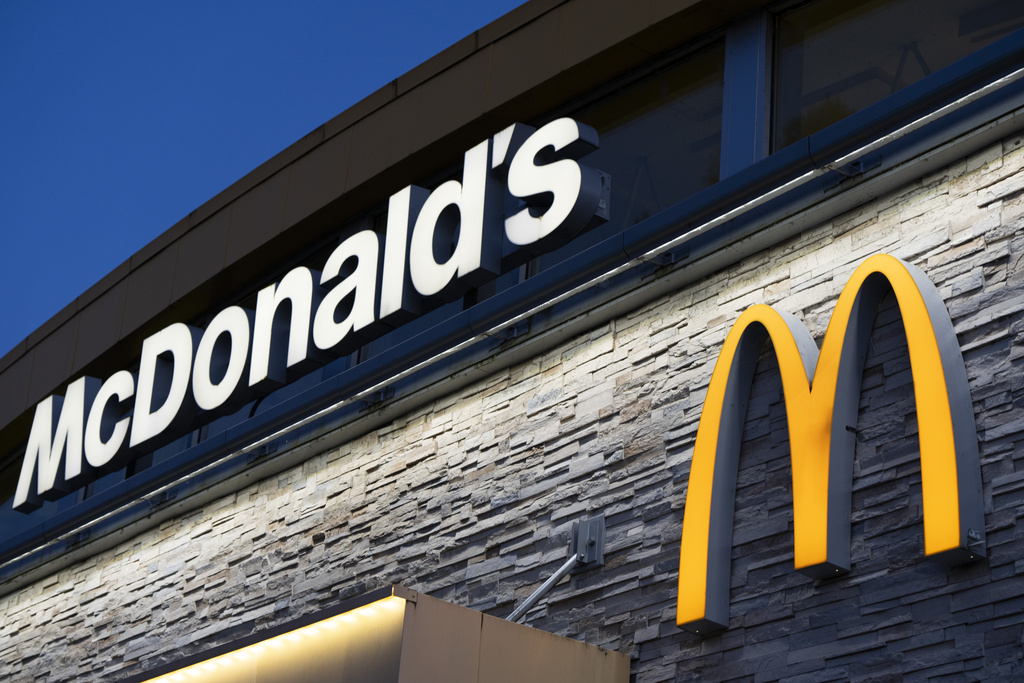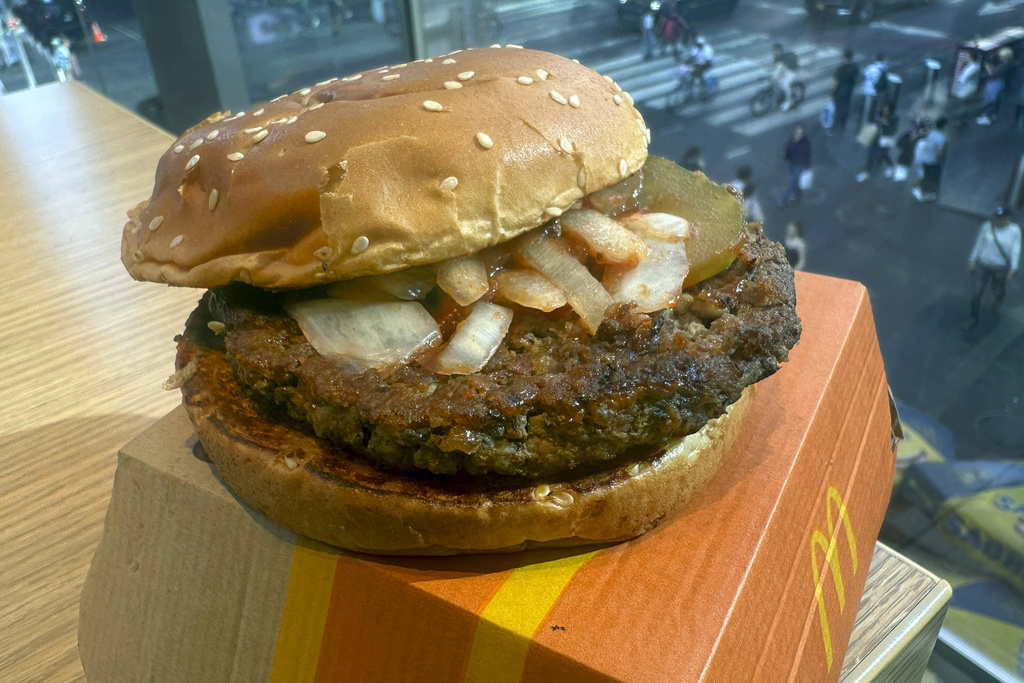McDonald’s E. Coli Outbreak, Quarter Pounder Recall in 12 States \ Newslooks \ Washington DC \ Mary Sidiqi \ Evening Edition \ McDonald’s is working with federal authorities after an E. coli outbreak linked to its Quarter Pounder hamburgers sickened 49 people across 10 states, resulting in one death. Raw onions are suspected to be the source of contamination, leading McDonald’s to pull Quarter Pounders from menus in parts of 12 states. Despite criticism from some experts, McDonald’s insists its food preparation practices are safe and that it is cooperating fully with investigations.

McDonald’s E. Coli Outbreak: Quick Looks
- Outbreak Summary: E. coli linked to McDonald’s Quarter Pounder has impacted at least 49 people across 10 states.
- Geographical Scope: Affected areas include 12 states, where McDonald’s removed Quarter Pounders from the menu.
- Health Impact: One person has died in Colorado, and at least 10 others have been hospitalized.
- Source of Contamination: Raw, slivered onions used on the Quarter Pounder burgers are the likely cause, according to initial investigations.
- Corporate Response: McDonald’s is seeking a new onion supplier and working with the CDC and FDA to resolve the issue.
- Expert Opinions: Some experts suggest McDonald’s should have closed affected stores for further investigation, but McDonald’s contends there’s no evidence of broader contamination risks.
- McDonald’s Track Record: The company is known for stringent food safety practices, but this outbreak has put its protocols under scrutiny.
- Outbreak Comparison: Other fast food chains, like Chipotle and Taco Bell, have faced similar E. coli outbreaks in recent years, underscoring the ongoing risks of foodborne illness.
Deep Look
McDonald’s is navigating a significant public health crisis following an E. coli outbreak tied to its Quarter Pounder hamburgers, which has affected 49 people across 10 states, according to the Centers for Disease Control and Prevention (CDC). One person has died, and 10 others have been hospitalized, with the outbreak prompting McDonald’s to remove the Quarter Pounder from menus in parts of 12 states. As federal investigators delve into the source of the contamination, McDonald’s is attempting to reassure customers about the safety of its U.S. restaurants.
The U.S. Food and Drug Administration (FDA) and CDC suspect the contamination likely originated from raw, slivered onions used as a topping on the Quarter Pounder. While McDonald’s also uses raw onions on some breakfast items, those products are not available in the affected regions. As a precaution, the company removed Quarter Pounders from menus in Colorado, Kansas, Utah, Wyoming, and portions of several other states, including Iowa, Missouri, and Nebraska.
This swift response highlights McDonald’s commitment to public safety, yet concerns remain over the broader implications of the outbreak. Some experts, such as Seattle-based foodborne illness lawyer Bill Marler, believe McDonald’s should have gone further by temporarily closing restaurants in the impacted areas. Marler warns that cross-contamination risks could persist until thorough investigations and cleanings are completed at each location. Despite these concerns, McDonald’s maintained that federal regulators had not found any issues with the company’s food preparation practices.
In an interview on NBC’s “Today” show, McDonald’s U.S. President Joe Erlinger suggested that the contaminated onions may have already passed through the supply chain. He assured the public that McDonald’s is working closely with federal health agencies to trace the outbreak’s origin and prevent further spread. Erlinger emphasized that McDonald’s is known for its rigorous safety protocols, which include regular testing of ingredients, such as the onions in question, for harmful bacteria like E. coli.
Nonetheless, McDonald’s now faces the task of finding a new regional supplier for fresh onions while continuing to work with investigators. The company is widely recognized for its stringent safety practices, and it remains confident in its ability to address this issue without widespread store closures. However, some customers, like Adriean Madden from Denver, are expressing uncertainty about returning to McDonald’s, feeling the company should be more transparent about the situation.
Madden explained that when he arrived at his local McDonald’s for an afternoon snack, there were no visible warnings about the E. coli outbreak, which gave him pause. “I feel like the information isn’t as widely spread,” Madden remarked. “This affects my decision with coming to McDonald’s in the future.”
Colorado, where Madden is based, has reported the highest number of cases, and it is where the single fatality, an older adult, occurred. State and local health officials are continuing to interview individuals about their recent food consumption to narrow down the exact source of the outbreak. Out of the 18 people interviewed by Tuesday, all had eaten at McDonald’s, and 16 of them reported eating a beef hamburger, with 12 specifically mentioning the Quarter Pounder.
While beef was initially considered a potential source, McDonald’s has ruled it out, citing that its burgers are cooked at temperatures high enough to kill E. coli. Instead, the company’s investigation has focused on onions, which are sliced and packaged by a supplier before being shipped to individual stores. McDonald’s has not disclosed the supplier’s name, but it confirmed that testing is regularly conducted on such ingredients.
The CDC reports that the type of E. coli implicated in the McDonald’s outbreak causes approximately 74,000 infections annually in the U.S., leading to over 2,000 hospitalizations and about 61 deaths each year. Although these numbers underscore the severity of such outbreaks, food safety incidents at fast food chains like McDonald’s remain relatively rare. In 2020, Chipotle paid a record $25 million fine for serving tainted food that sickened more than 1,100 people with E. coli from 2015 to 2018. Taco Bell also faced a similar incident in 2006, when green onions contaminated with E. coli sickened at least 71 people.
Despite the ongoing investigation, some industry experts believe McDonald’s is well-equipped to manage this crisis. Aaron Allen, a restaurant consultant, stated that McDonald’s extensive experience and safety protocols should enable it to recover from the outbreak without lasting damage to its brand. However, the fast-food giant’s stock fell by 5% following news of the outbreak.
McDonald’s has pledged to continue cooperating with federal regulators to ensure the safety of its products and prevent future incidents, but the company still faces challenges in regaining customer trust amid the ongoing investigation.







